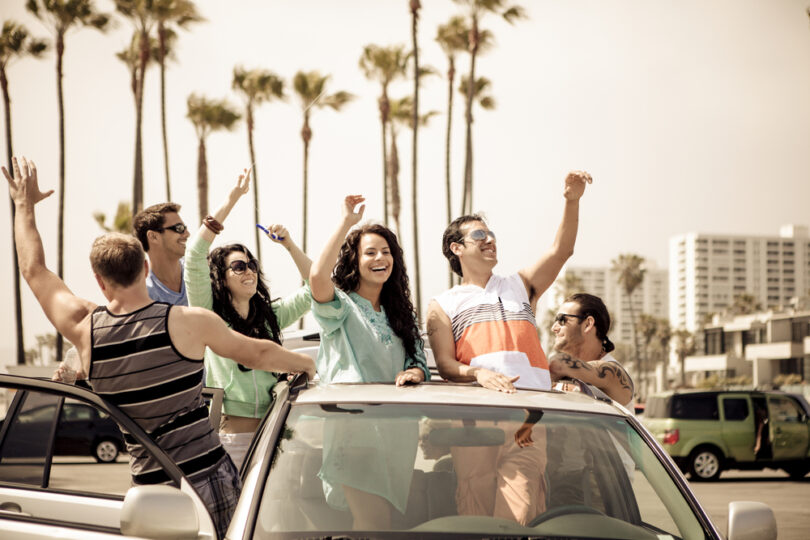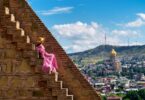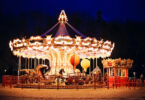The city of Los Angeles is known not only for its Hollywood glam and beautiful people, but also its awesomely vibrant Hispanic population. The city has a long and colorful Hispanic heritage — dating back to the time Spanish missionaries founded a settlement and named it “El Pueblo de Nuestra Señora La Reina de Los Ángeles” (which translates to “The Town of Our Lady the Queen of the Angels”), which later went on to be ruled by a newly independent Mexico, and then was ceded to the United States.
With such a rich Hispanic heritage, there is so much to see and experience — so where would you start? Fear not: we’ve got the ultimate guide of LA locations for anyone eager to learn more about Hispanic culture and history.
Olvera Street
 Known as the “birthplace of Los Angeles,” Olvera Street is a bustling outdoor marketplace that will transport you back in time. In addition to attracting visitors with its quaint old buildings, shady trees, and brick-lined walkways, it acts as a hub for Hispanic cultural performances, historical sites and museums, food, music, arts and crafts, and much more. If you need a starting point for your celebration of Hispanic culture in LA, then this is the place!
Known as the “birthplace of Los Angeles,” Olvera Street is a bustling outdoor marketplace that will transport you back in time. In addition to attracting visitors with its quaint old buildings, shady trees, and brick-lined walkways, it acts as a hub for Hispanic cultural performances, historical sites and museums, food, music, arts and crafts, and much more. If you need a starting point for your celebration of Hispanic culture in LA, then this is the place!
La Plaza de Cultura y Artes
Just a short walk from Olvera Street will bring you to La Plaza de Cultura y Artes. Here’s where you can engage yourself with a ton of modern interactive exhibits that talk about how Mexican culture has molded the identity of today’s Los Angeles. Visitors can choose from many rotating educational programs while there are regular cultural events and celebrations.
El Pueblo de Los Angeles Historical Monument
Also encompassing Olvera Street and the immediate surroundings is the historic El Pueblo de Los Ángeles Historical Monument, AKA the Los Angeles Plaza Historic District. It’s the oldest part of the city and has a plaque that commemorates the city’s founding and the arrival of the very first families to the new pueblo. It’s a treasure trove for history buffs, as well as houses beautiful architectural gems like the Nuestra Señora La Reina de Los Ángeles Church, Avila Adobe (the city’s oldest surviving residence), Pico House (an old Italianate-style hotel), and the Old Plaza Fire Station.
The 24th Street Theater
The 24th Street Theater acts as not only a venue for great theatrical performances for Spanish-speaking audiences but also a platform that encourages people in the Hispanic community to get involved on and off the stage. You can catch intense dramas, laugh-out-loud comedies, and even colorful Mexican puppet shows — there’s something for the whole family!
Conga Room
 For those who want to connect with Hispanic culture by breaking out some dance moves, you have to wind up at the Conga Room. The legendary music venue showcases Latin music artists and DJs that mix and match all the rhythms of Latin America. Paintings and sculptures from Hispanic artists adorn the space, adding to the unforgettable authentic ambiance. It’s a wonderful celebration of Latinx culture, so make sure to end your night!
For those who want to connect with Hispanic culture by breaking out some dance moves, you have to wind up at the Conga Room. The legendary music venue showcases Latin music artists and DJs that mix and match all the rhythms of Latin America. Paintings and sculptures from Hispanic artists adorn the space, adding to the unforgettable authentic ambiance. It’s a wonderful celebration of Latinx culture, so make sure to end your night!
Los Angeles County Museum of Art
 For an in-depth look into Hispanic history in Los Angeles, look no further than the Los Angeles County Museum of Art. One of the largest art museums in the Western United States, encompassing 150,000 pieces of work, the expansive museum is home to art from nearly every corner of the globe, with a special focus on Hispanic artworks. Here, visitors can examine artwork from Spanish colonial artifacts from the 17th century to modern Latin American art from today’s best Hispanic artists. Older artifacts include historic furniture, household items, and clothing.
For an in-depth look into Hispanic history in Los Angeles, look no further than the Los Angeles County Museum of Art. One of the largest art museums in the Western United States, encompassing 150,000 pieces of work, the expansive museum is home to art from nearly every corner of the globe, with a special focus on Hispanic artworks. Here, visitors can examine artwork from Spanish colonial artifacts from the 17th century to modern Latin American art from today’s best Hispanic artists. Older artifacts include historic furniture, household items, and clothing.
The contemporary collection houses paintings, sculptures, and even a video installation. These modern-day artists hail from numerous countries, with some of the most common being Brazil, Argentina, and Mexico. Informative texts relay multiple Hispanic countries’ history, with insight from Hispanic artists on their various influences. In addition to the artwork, the museum often holds various events dedicated to the art, including concerts, lectures, and poetry readings. There is something for every art-lover to find here with such a vast range of works and talented artists!
América Tropical Interpretive Center
Though many artists have appeared and left their mark in Los Angeles, one of the most famous remains David Alfaro Siqueiros. His work, América Tropical, has resonated with individuals in the community for decades and continues to be an important part of Hispanic culture in Los Angeles. The mural was originally created in 1932 and faced immediate controversy from some for its stark look on American imperialism and the blend of politics. At the same time, many residents praised the work for its rich detail and daring message.
As time went on, supporters of the mural and fans of Siqueiros requested that the mural be preserved, as they believed it was imperative to understand the culture at the time. Today, the América Tropical Interpretive Center has conserved the mural after the damage it faced over the years due to weather forces and put it on display for the next generation of los Angelenos to explore. In addition to the mural, there are headsets available that provide a detailed history of the artist and mural, along with an informative video, making for one of the ultimate educational experiences in the city.
Grand Central Market
 Grand Central Market is one of the central points for Hispanic Culture in Los Angeles, especially for food. The market began over 100 years ago, first starting as a general market that sold various food that reflected the local community, including baked goods, meats, and Jewish delis. In 1984, the market was bought and renovated by developer Ira Yellin, who created a vision that promoted an inclusive community for all residents to enjoy.
Grand Central Market is one of the central points for Hispanic Culture in Los Angeles, especially for food. The market began over 100 years ago, first starting as a general market that sold various food that reflected the local community, including baked goods, meats, and Jewish delis. In 1984, the market was bought and renovated by developer Ira Yellin, who created a vision that promoted an inclusive community for all residents to enjoy.
Nowadays, foodies will have more options than ever for a meal or snack here, as there is food from over two dozen vendors, many of them from Latin America. Many locals come here to stock up on their weekly groceries, while tourists dip in for a delicious breakfast or lunch. Highlights include Chiles Secos, which offers traditional Latin American grocery items such as dried beans and grains, as well as Sarita’s Pupuseria. At Sarita’s, owner Sara Clark works from family recipes to create some of Los Angeles’ tastiest pupusas from El Salvador, among other savory Salvadorian dishes.
You May Also Like: How Well Do You Know Hispanic Heritage? Take Our Quiz & Find Out!
Latino Art Museum at the Pomona Art Colony
This museum is focused purely on Latino art and showcases contemporary Latin American artists who reside in the United States. The artists create work that speaks to their Hispanic heritage and story. Past exhibitions have included artwork from Guatemala, Mexico, and Peru, with recent exhibitions looking at Hispanic women’s artwork. There are paintings, photographs, drawings, sculptures, and interactive pieces to be found here. In addition to the large variety of collections, there are art classes for children and adults alike, focusing on improving drawing and painting skills.
These classes are great for locals and visitors alike as a one-time experience or a weekly event, with local artists giving valuable feedback to improve their work. During the classes, participants will examine artwork from many Hispanic artists to better understand Latin American artistic culture and its influence on the rest of the country. As a non-profit organization, the Latino Art Museum solely runs on donations and dedicated volunteers who are passionate about promoting the Hispanic culture to the city. Any visitor to this museum will surely develop a greater understanding of the Hispanic history in Los Angeles.
Know of any other places in LA that celebrate Hispanic culture and history? Share them with us in the comments!








